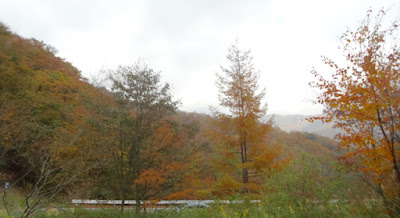華厳の滝 / Kegon Falls
日光は私達は2回目です。
真冬で景色が違い、訪れた場所もいろは坂を除いて、違いました。
華厳の滝 (ケゴンノタキ)、
竜頭の滝 (リュズノタキ)、
湯滝 (ユダキ) が "ウリ" でした。
私は、コースの説明を読む前に、"奥日光三名瀑"がどの滝のことかも知りませんでしたが、目的が紅葉で日帰り旅行の条件にあったこのコースを選びました。
実際に訪ねてみるとどの滝もそれぞれ特色があり、感動を誘う景色で、"奥日光三名瀑" と言われる意味も理解しました。
華厳の滝は、"奥日光三名瀑"の中だけでなく、日本三名瀑の中にも数えられています。
日本は狭い土地に、山と川がたくさん、滝が多いのも当然なことなのですね。
Kegon Falls
The first visit was in winter so the views were different and places were different except Irohazaka Winding Road : ★.
Kegon Falls : ★, Ryūzu Water Falls : ★ and Yudaki Water Fall ; ★.
Club Tourism site: ★
Before I read information of the trip, I did not know which falls were the Okunikko Three Great Falls, although our main purposes were autumn colours and to have
a day trip and we selected this.
Actually we visited the three Falls which have their own distinct characters, impressive views and I understood why they say Okunikko Three Great Falls.
From our coach, I saw views of Lake Chūzenji : ★, Senjōgahara : ★ and Irohazaka Winding Road.
The Kegon Falls is in "Okunikko Three Great Falls" as well as "Japan Three Great Falls".
"Japan Three Great Falls" are the Kegon Falls and the Nachi Falls, but there are many candidates for the Third.
Japan has many mountains and rivers in a small land, indeed naturally there are many falls, aren't there?
車窓から / From Coach Window
 |
| 神橋 (シンキョウ) 日光に入ってきました。と言えるのもこの橋は日光の玄関口と 言われるところだからです。 川は、大谷川 (ダイヤガワ)で、これから向かう、華厳の滝も中禅寺湖も この上流にあたります。 下流で鬼怒川に合流し、その後、利根川 (トネガワ) に合流します。 神橋の伝説も面白いです→★ 神橋は、国宝かつ、世界遺産です。 1590年に建造され、その後数回改築、2度、再建築されています。 この橋、一般の人は渡りきることができないそうです。 料金を支払っても入るだけ....そんな橋があるのですね。 Shinkyo Bridge ; God Bridge : ★ I can say we were entering the Nikko area, because they say this bridge marks the entrance to Nikko. This river is the Daiya River. We were going to Kegon Falls and Lake Chūzenji, parts of the upper river. Lower down, the Daiya River meets the Kinu River and later flows into Tone River. Do only I feel it is interesting to follow a river's flow? Normally people cannot walk all the way across. Even though people pay a fee they can only enter, but not cross. I was surprised there is a bridge anywhere in the world. Originally built in 1590, later repaired a a few times and twice rebuilt. The bridge is a Japanese National Treasure as well as a World Heritage Site. |
 |
いろは坂
: ★
馬返
(ウマガエシ)
から、中禅寺湖への登り方向は「い」から「ね」の
'第二いろは坂'。
1872年まで、男体山 (ナンタイサン)
は、女人禁制、牛馬禁制で、
馬返 の地名はここに由来しています。
Irohazaka Winding Road
It
has 48 hairpin
turns.
The
explanation is here→★ カーブを数える人もいるのでしょうけれど、 私はしませ〜ん。 I think some people count the curves, although I don't. |
 |
|
Lake Chūzenji
Lake Chūzenji and Kegon Falls are in Nikkō National Park.
The altitude of the surface of the lake is 1,269m, they say the highest in Japan,
although there are a few different candidates.
The Mount was discovered by a Priest, Shōdō (735 - 817) in 782
and later considered sacred, the mountain was closed to women, horses,
And also the mountain is one of 100 Famous Japanese Mountains. and cows until 1872. |
 |
| 華厳の滝' 近く / Close to 'Kegon Falls' : ★ |
到着 / Arrive
 |
| 案内図 / Guide Map in Japanese Map and Explanation in English are here →★  案内板の後ろは秋、真っ盛り Behind the Guide Board is Autumn at its Best.   |
華厳の滝を上から見る
Look down at Kegon Falls from Above
 |
| 当たり前のことなのに、滝の上には川があると気付かされます。 中禅寺湖から流れ出た水がここにきます。 Although it is normal, I realized that the top of a fall is a river. The water comes from Lake Chuzenji.   |
 |
こういう迫力ある景色は私の写真では表現できませんがせめて最大のサイズにしてみました。
|
 |
| 滝壺 / The Basin |
下からみる / Looking Up the Fall
 |
驚き!
岩盤をくり抜いたエレベーター ('華厳滝エレベーター') で滝壺近くまで降りて行けるのです。高低差は100m。
便利なものを作るな〜と関心する反面、なぜか罪悪感も抱いていました。
滝の高さは約97m、落口巾 (オチグチハバ) は7mメートル、滝壺の深さは4.5m。
Surprising!
We can go close to the basin by their lift which is dug out of the bedrock. The lift goes down 100m.
They
made such a convenient thing, I was impressed as well as somehow I
had a sense of sin.
The
height of the Fall is 97m, the width at the top is 7m and the depth
of the basin is 4.5m.
The highwater
flow is normally 1.5 tons per minute
and I heard it can change from 0 ~ 40 tons by precipitation or typhoons.  |
 |
| 落口 / The top |
 |
大谷川 / Daiya River  |
 |
| 華厳渓谷 / Kegon Gorge |
 |
| 駐車場の木 死木なのでしょうか? でも形は生きているような感じがします。 Car Park Tree Is the tree dead? However, from the form I feel it is alive. |




0 件のコメント:
コメントを投稿